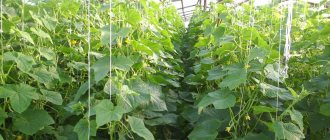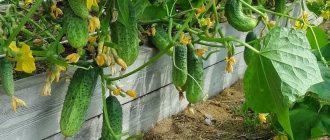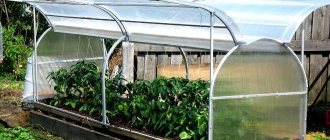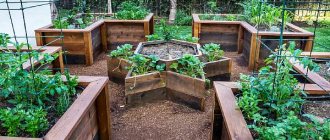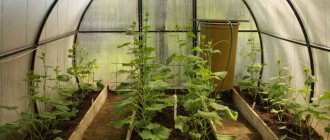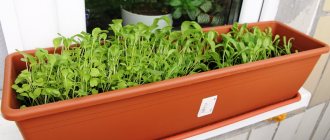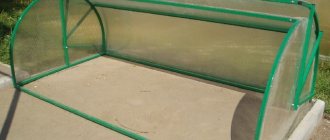Getting an early harvest of cucumbers is the dream of any gardener. For a heat-loving culture, sun rays alone are not enough. Creating certain conditions will speed up the process of fruit ripening. A warm bed is what you need to speed up the early harvest. It turns out that without a greenhouse or greenhouse it is possible to grow an early harvest without additional financial costs, using natural biochemical processes.
Principle of operation
The name “warm bed” speaks for itself - it should warm. Not all gardeners know what and how to keep warm. The process is based on organic and physical reactions. The dacha is full of all kinds of plant waste:
- mown grass;
- weeds;
- food waste;
- dry leaves;
- waste paper;
- branches and bark of trees and shrubs.
This unnecessary garbage will serve as a good basis for a warm garden bed. When organic matter overheats, it releases a lot of heat, warming the soil. And the decomposed substances turn into valuable fertilizer - humus.
The “insulating” material needs to be laid out in the place of the future cucumber bed. The bottom layer should consist of large coarse fragments: branches, thick stems, bark. This is a kind of drainage that ensures air circulation. The next layers will be made up of smaller organic matter: foliage, grass, weeds, food waste. When laying out layers, it is advisable to water them in order to increase the moisture content of the organic material, and therefore set in motion the process of fermentation and decomposition. This chemical reaction will create the heat needed to grow the crop.
Raw materials affected by rot and disease cannot be used, as they can become a source of disease not only for the leaves, but also for the fruits of cucumbers.
The “stuffing” for warm beds can be prepared in advance. To do this, you need to set aside (fence off) a certain place on your personal plot, where various dacha waste will gradually be deposited.
Advantages
Warm beds for cucumbers are gaining popularity every year. And it is no coincidence, because few summer residents keep livestock or poultry. Receiving sufficient heat and nutrition from rotting organic matter, cucumbers produce an early harvest.
Benefits include:
- early sowing of crops, early fruiting;
- the soil contains all the necessary nutrients and microelements;
- the insulating material subsequently turns into valuable fertilizer;
- temperature changes are not harmful not only to plant roots, but also to young shoots;
- thanks to heat, the yield increases and the duration of fruiting increases;
- the design does not require financial costs and is easy to construct;
- dacha waste is disposed of beneficially;
- the bed is obtained with natural drainage;
- There is no need to dig up the soil; the multilayer structure allows it to always remain loose.
If the site has heavy soil or groundwater is close to the soil surface, such a bed is an ideal option not only for growing cucumbers, but also other pumpkin crops.
The disadvantages of this design are minor:
- frequent moisturizing;
- adding fertile soil twice a year.
Warm bed for cucumbers without manure
Whatever the design of the warm bed, its main purpose is to generate heat. The dacha waste used in the construction of the garden bed, when overheated, warms the soil and plant roots. In warm nutrient soil, microorganisms multiply well and produce carbon dioxide, which is beneficial for the growth of vegetable crops. This is a good guarantee for getting a large harvest of cucumbers.
Recessed type
This type of warm bed is suitable for areas with arid climates. To create it, a trench is dug, the average depth of which is 50 cm, the width is no more than 150 cm. If the soil on the site is clayey, you need to lay sand drainage at the bottom. Many gardeners place plastic (closed) bottles under the drainage layer to prevent deep cold from penetrating to the root system of the crop.
Organic matter is laid out in layers: from below - branches, roots, bark; then comes plant materials and household waste - grass, hay, paper, sawdust, food waste. You can place a low wooden box around the perimeter of the bed. Leave the top of the structure at ground level or raise it a little higher. You can do without a box. The top layer should be fertile and nutritious.
The finished bed is watered with water heated to +90 degrees, covered with a dark film so that it warms up well. This bed will last for five years.
On the soil surface
One of the simplest designs in terms of labor intensity. This is a kind of raised bed. Its construction does not require any building materials. The heat-generating layer is laid directly on the surface of the earth. It is covered with a layer of soil on top. The resulting elevation is poured with hot water to speed up the thermal process. The bed is covered with a dark film so that it warms up well. Soon you can plant cucumbers.
Elevated
This type of cucumber bed is usually built in areas where there are long, cold winters and cool, rainy summers. This design is similar to an embankment or hill, the average height of which is 60 cm.
The raised bed is arranged as follows:
- In the selected area, remove turf to a depth of about 30 cm;
- A metal mesh with small cells is placed at the bottom, which will serve as an obstacle for rodents;
- Coarse organic matter - tree branches and bark - is laid out in the central part of the pit;
- Then they are filled with layers consisting of fine organic matter;
- The topmost layer of the structure is soil, its thickness should be at least 20 cm.
In a barrel
A good option for creating a warm bed is a barrel. In the spring, when the snow has melted, the barrel is installed in a vertical position in the sunniest area. The barrel is filled with plant remains and food waste. After a week, the organic matter will settle and it will be filled again with vegetation and kitchen waste. This must be done until the subsidence stops completely. At the end of May, fertile soil is poured into the structure up to the edge of the barrel and watered with hot water.
By overheating, the organic matter will release the heat necessary for the cucumbers. The barrel is covered with film. The covering material will not damage the seedlings, since the soil will gradually subside while the cucumbers germinate (sown dry), leaving the necessary distance for plant growth. Such shoots are not afraid of night frosts. The film is removed completely when the weather becomes stable.
This structure allows you to save space on your personal plot, and the harvest of cucumbers is not inferior to those grown in the garden.
With freshly cut grass
Such a warm bed is set up in the spring right in the open ground. You need to dig a shallow trench and fill it with freshly cut grass without seeds. You need a lot of grass, because when it withers, it settles. The green mass should be compacted. Boiled potato peelings and kitchen waste can be placed on top of the grass to start the fermentation process. Pour soil on top - it should be above the surface of the earth, otherwise the cucumbers may rot in a rainy summer. Pour boiling water over the cucumber plant and cover with foil.
From tires
This design will require three car tires. Place cardboard under the first tire to prevent weed growth. Place drainage onto the cardboard. The second tire is filled with compost and food scraps. Compost is poured into the third device, and planting soil is placed on top. Hot water is poured onto the ground.
Planting holes are dug around the structure. Two cucumber seeds are sown in each hole.
Hanging boxes
Boxes for growing cucumbers can be hung in a greenhouse. A film with holes for drainage is laid out at the bottom of the container. Then a thin layer of sand is poured. The top layer is nutrient soil. Cucumbers are planted. The box is placed on a support or suspended.
Tips for caring for cucumbers in a greenhouse
When growing cucumbers, it is necessary to provide them with the necessary conditions, which involves periodically carrying out mandatory activities.
How to grow cucumbers: care in a greenhouse:
Watering
The vegetable is demanding regarding soil moisture. The frequency of watering depends on climatic conditions and the age of the cucumbers. It varies from once a day to once every two days. Moreover, you cannot use cold water from the tap.
Water consumption rates:
- plants during growth period: 5 l/1 sq.m.
- during flowering: 8 l/1 sq.m.
- during fruit ripening: up to 15 l/1 sq.m.
A lack of moisture or, conversely, its excess affects the number of ovaries, the taste of fruits (they may taste bitter), the condition of the foliage (begins to turn yellow), and plant disease.
Loosening
It is recommended to loosen the soil periodically (superficially so as not to damage the roots). This allows you to saturate the soil with oxygen. Loosening is carried out after watering. To retain moisture longer, you can lay mulch (cut grass, straw, sawdust, etc.) under the cucumbers.
Ventilation
To regulate the humidity in the greenhouse and temperature conditions, it is necessary to open the side transoms. There should be no drafts.
Top dressing
Both organic and mineral types of fertilizers are used as fertilizers for cucumbers.
Plants are usually fed:
- before flowers appear;
- during flowering;
- during the period of fruit ripening.
Garter
To make plants grow better and take care of them more conveniently, it is recommended to use various types of supports: horizontally stretched cords, nets, trellises, etc.
Bush formation
Methods for correcting plant development vary depending on their type. On varietal cucumbers, female flowers (with ovaries) are formed on the lateral shoots. Barren flowers usually appear on the main stem. Therefore, attention should be paid to the side lashes. Hybrids mainly produce female inflorescences. And both on the stem and on the shoots. In this case, it is recommended to form the main vine (by pinching the side ones), which will receive maximum light and nutrition.
It is better to remove all shoots and leaves at a distance of 15...20 cm from the ground. This way you can provide better ventilation to the plants.
Harvesting
Fruits must be removed at least once every two days. Otherwise, the formation of new ovaries may be delayed. It is better to choose morning or evening hours for harvesting.
Creating a warm bed with manure
A manure bed is in no way inferior to greenhouses in the amount of cucumbers grown, since the decomposition of this organic matter releases a lot of heat. It is possible to grow greens in such a warm garden bed in open ground even in Siberia. The first place in terms of heat transfer is occupied by horse manure: for 1.5 months, when overheated, it maintains a temperature of +75 degrees.
The bed is laid out several weeks before planting the seeds. The creation sequence is as follows:
- In the selected area, remove the top soil layer to a depth of a spade bayonet (30-35 cm). The average width of the bed is 90 cm, the length is arbitrary;
- The bottom of the trench is covered with a metal mesh with small cells. The mesh will prevent rodents from entering;
- Branches of trees and shrubs can be laid out as drainage;
- Lay the main layer - manure, 20-25 cm thick;
- The top layer is fertile soil or a mixture of humus and garden soil in equal proportions;
- In order for the manure bed to begin to generate heat, it must be thoroughly poured with boiling water;
- To warm up, cover with film for about a week. The appearance of condensation on the film indicates that the bed has begun to work. The film can be removed.
The bed is ready for sowing.
If the amount of raw materials is limited, then you can arrange warm holes in the garden bed. The technology for preparing the bed is the same, only a separate hole is prepared for each plant.
Tilling the soil before planting
The application of useful components is carried out several days before planting, so that the soil has time to be saturated with vitamins. The following mixtures are suitable for this:
- A solution of potassium permanganate helps disinfect the soil and prevents the development of fungal diseases. To prepare a solution, take 20 g of potassium permanganate per 1 liter of water. Watering is carried out two days before planting the seeds.
- Copper sulfate is also used in solution: take 30 grams of the substance per 10-liter bucket of water (not very cold). Then, after 2-3 hours of infusion, you can water the bed. This treatment is recommended a week before planting.
- Minerals are added before the beds are created. Superphosphate, wood ash, nitrophoska or potassium sulfate are used as such fertilizers.
- If the soil has a high level of acidity, add a small amount of lime (about 100g).
- Depleted soils are fed with organic matter. For such fertilizing, take well-rotted manure (not much, 3-5 kg is quite enough) and immediately add 50 g of minerals.
- After applying any fertilizer, you need to carefully dig up the soil, loosen it and level it with a rake. Then the bed is left alone for several days so that the fertilizers are thoroughly absorbed.
Selecting a location
Choosing a location is the first step when laying out a warm bed for cucumbers.
Warm garden bed in open ground
Cucumbers love warmth and sun. Therefore, the place for the garden bed in open ground should be sunny and protected from the wind. The ideal location of the structure is from east to west. This placement will allow the entire area of the bed to warm up during the day.
Warm bed in the greenhouse
Warm beds in a greenhouse are laid out in regions with unfavorable climatic conditions, where summers are cold and with significant temperature changes. The soil in this design can be additionally heated.
The simplest structure is a box, the walls of which can be made of wood, slate, brick and even plastic bottles.
When to make a warm bed
A warm bed can be prepared for planting cucumbers both in spring and autumn.
Warm bed in spring
Construction of the bed in the spring should begin after the snow has melted. You will have to wait a little for the soil surface to warm up; cold soil will slow down the rotting reaction. To speed up the process of warming up the earth, you can put a film on the area allocated for the garden bed.
When the soil has warmed up, you can begin to lay out the structure of the bed. Biomaterials should be used with a short decomposition period, large ones should be crushed. When laying organic matter, it must be compacted well, otherwise, overheating, the layers will settle and the cucumbers will sink deep. It will be inconvenient to care for a crop if it is planted on a high bed, in a box or barrel.
On top of the beds you can place arcs on which to stretch film or agrofibre. In this case, the cucumbers will be heated not only from below, but also from above. It is possible to plant a crop in such a greenhouse even with slight night frosts. The shelter must be removed during the day, otherwise on a hot day the cucumbers may burn due to the high temperature in the greenhouse.
Warm bed in autumn
A warm bed can be prepared in the fall. Conditions for this are even more favorable than in spring. Firstly, the ground is not frozen. Secondly, there are a lot of different plant residues - tops, mown grass, leaves, weeds. Thirdly, the gardener has more free time, and fourthly, the garden bed will shrink and the processes of rotting will begin earlier in the spring.
There are also two minor disadvantages:
- Mice can nest in plant debris. To prevent this from happening, a metal mesh is spread at the bottom of the bed, and the first layer is covered with branches of thorny bushes - gooseberries, raspberries, spruce or pine branches;
- a garden bed built long before the cold weather will become overgrown with weeds. To protect against weeds, the structure should be covered with a covering material that does not allow sunlight to pass through.
How to prepare the greenhouse and soil before planting
Despite the fact that cucumbers are not as capricious as some other vegetable crops, it is necessary to create suitable conditions for their development. In this case, you need to devote time both to choosing the greenhouse itself and to arranging the beds.
The best option for planting cucumbers is a polycarbonate structure. If vegetables were previously grown there, plant residues, if any, should be removed. Both the greenhouse and trellises (if they have been installed) should be treated for infections before planting. This will have to be done about a month before planting the cucumbers. The simplest option is to spray the structures with Bordeaux mixture.
Of course, it is best to completely replace the soil before planting vegetables. However, not everyone can do this. In this case, it is recommended to remove a layer of soil mixture about 15 cm high (sprinkle the remaining one with boiling water) and bring a new one to this place. You can also use a solution of potassium permanganate to destroy pathogenic microorganisms. After disinfection, the soil must be dug up.
If fertilizers were not applied in the fall, you will have to do so in the spring. First of all, cucumbers need organic matter. It is also recommended to add potassium, phosphorus and nitrogen to the soil (complex formulations can be used).
Growing cucumbers in a greenhouse is impossible without the availability of high-quality planting material. Before planting, you need to check the seeds. To do this, they need to be dipped in a salt solution. Those that cannot ascend will float.

